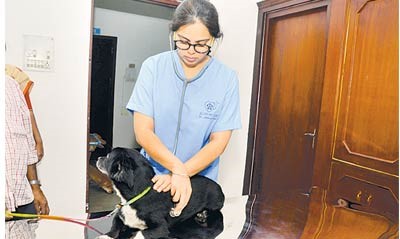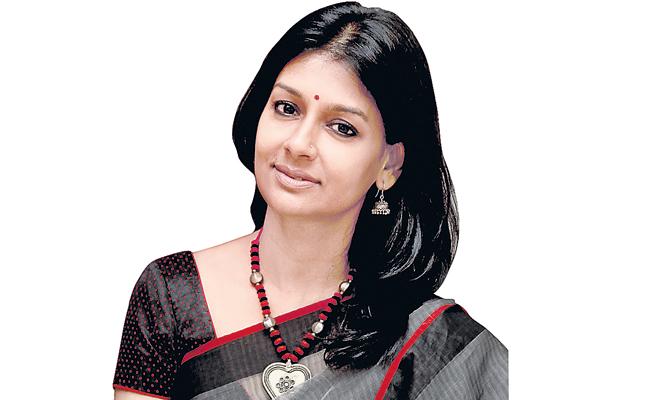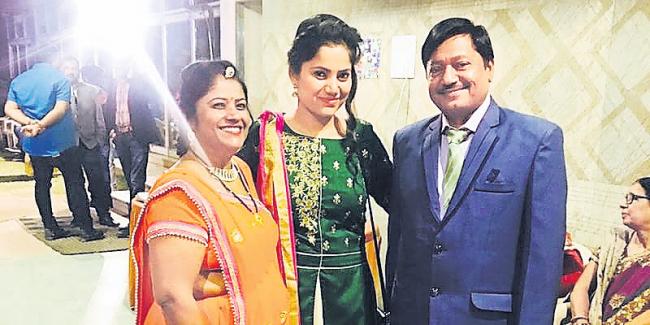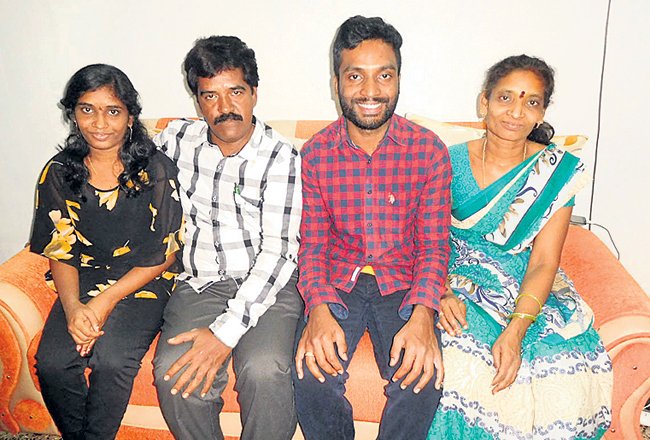Worlds largest Dinosaur to be exhibited in Chicago Museum
Chicago sources reported that the cast skeleton of the largest dinosaur discovered to date will go on exhibit in a recreation of what would have been its home in present day Argentine Patagonia at Chicago’s Field Museum starting June 15. Meanwhile the 37 m (122 ft) long cast, dubbed Maximo, occupies one third of the museum’s Stanley Field Hall and its head pokes out from a balcony 8.54 m (28 ft) high.
Accordingly Maximo is a long necked mega-herbivore in the family of Titanosaurus. Field Museum president Richard Lariviere said in a statement said “Our goal as an institution is to offer visitors the best possible dinosaur experiences and we want that to start right when visitors first enter Stanley Field Hall”.
He said “The new titanosaur is huge and it looks amazing in Stanley Field Hall. It is the perfect home to display the world’s largest dinosaur”. Maximo will not be alone and moreover around the skeleton there will be floating gardens and life-size reproductions of a flock of giant flying reptiles, some of them 9.7 m long, the length of a school bus. Further the Maximo model was created from the fossilized bones of seven individual dinosaurs of the same species excavated from a quarry near La Flecha, Argentina.
The Rock celebrates kid’s first Mother’s Day
Dwayne Johnson wrote the sweetest Instagram post to his lady love Lauren Hashian, whom he has two daughters with. He once again proved that The Rock truly rocks!
Along with an adorable photo of his longtime love with their girls, two-year-old Jasmine and newborn Tiana, the actor wrote a lengthy post. “Happy Mother’s Day to my main squeeze @laurenhashianofficial, holding my little main squeeze, Jasmine Lia, who’s holding my tiniest main squeeze, Tiana Gia – both our daughters middle names are in honor of their great grandmothers, Lia and Giavanna.”
The 46-year-old wrestler-turned-actor, who has been with Lauren since 2008, then added that he’s “in constant respect and grateful awe of all the things this incredible mama accomplishes on a daily basis.”
Emily Ratajkowski responds to marriage critics
Emily Ratajkowski opened up about her marriage and about how she had to go through criticism for her decision.
Apparently, there were many who thought that her marriage wouldn’t last and they were even taking guesses on its longevity.
She shared in the June 2018 issue of Marie Claire, “People came after my marriage, like, ‘Wow. I give it three weeks.’ I’m like, ‘What?’ No one can take women seriously on any choices that they make, especially if they’re unique to them and they don’t play into the way we think women should get married. It’s a constant writing-off.”
ShaktiPeeth – Sri Chamundeshwari Temple, Mysore
The Sri Chamundeshwari Temple is situated on the Chamundi hills, about 13 kms from Mysore city.
The temple is considered as one of the 18 Maha Shakti Peethas and dedicated to Goddess Chamundeshwari, who is believed to be a form of Goddess Parvathi. Built in the Dravidian style, this temple consists of a main doorway, an entrance with a silver door, the Navaranga Hall, the Antharala Mantapa, the sanctum sanctorum and Prakara. The original shrine was built in the 12th century by the Hoysala ruler, King Vishnuvardhana. The tower of the temple was built in the 17th century by the Vijayanagar rulers. The temple assumed significance after the Wodeyars of Mysore came into power in 1399 AD.
Neighbouring this temple are other temples on the hill like the Mahabaleshwara temple, Nandi temple and a Devi Kere (a pond).
Shri Balaji Sansthan, Washim, Maharashtra
A newly formed district of Maharashtra, Washim includes the tehsils Risod, Malegaon, Mangrulpir, Karanja and Manora. Washim, which is also known as Vatsagulma was the seat of Vakataka dynasty.
Venkateshwara Balaji Temple or Shri Balaji Sansthan is an important pilgrimage temple in Washim.
Built in 1779 AD by Bhavani Kalu, who rose to be the diwan of Sabaji Bhosle and Janoji Bhosle, it is said to have taken twelve years to build the temple and its supporting structures. The story goes that in 1760, a horseman dug up the ground near the temple and found idols of Ganapati, Parvati, Vishnu, Brahma, Vishnu, Mahadeva and others including the one of Venkateswara Balaji inside the temple now. They were buried during the reign of the Mughal emperor Aurangzeb to save them from destruction.
The deity is made of black stone and is adorned with jewels. The top of the temple gateway affords one a great view of the town. A gold-plated dome has been recently added over the inner chamber of the temple.
At the time that these idols were discovered, Bhavani Kalu, who had been the patvari of the village Khadi Dhanini in Mangrul tehsil had become the Divan (or according to some accounts, a general) of the Bhosle Rajas, and was at Bashini. He got the temple built, with its structures including the large paved quadrangle, a well-built verandah for pilgrims to stay, a bhandara for Brahmins to be served food and various offices.
According to an inscription on a pillar in the front of the temple the work was finished in 1700 Shaka, AD 1776. The Dev Talay or Balaji Talav, a large square tank with sides built out of stone and a Jalakridasthana, resting-place for swimmers, in the middle, was made at the same time.
Legend has it that Tirupati’s Lord Balaji comes here to rest at this temple after the harvest. A temple fair is held in a big way in honour of Balaji in the Ashvina month (September / October).
Bhawani Waghjai Temple, Terav, Ratnagiri, Maharashtra
Ratnagiri is famous for its mangos, lush green mountains, majestic coastline, and little villages like Terav that are home to some very beautiful and important temples like the Bhawani Waghjai Temple. For over 350 years, the locals in this area of the Konkan coast were worshipping at the temples of Lord Shiva, Goddess Waghjai, Goddess Bhawani and Shri Hanuman in the village. Their cultural lives revolved around these temples and in recent years they were concerned that these temples would not be able to withstand the salty winds from the sea anymore. Unwilling to lose these important temples to the vagaries of the weather, the village created a trust and raised funds to build a strong new temple that could house all these important deities. Thus, in 2003, the Shri Bhawani Waghjai Temple was opened to one and all.
This new structure is a large temple with four tall white shikharas that tower over the 17-acre temple grounds. Surrounded by beautifully planned and well maintained gardens, it gives the devotees an opportunity to fully soak in the powerful vibrations of this sacred place without being disturbed by the noise and chaos of the outside world. Inside the temple, the artisans have taken inspiration from South Indian temples for the ornate carvings and have built large marble floored halls that can accommodate the large crowds that gather for Navratri and other important festivals like Hanuman Jayanti. This place is famous because it is the only temple in Maharashtra that has a shrine dedicated to Navadurga (the nine forms of Durga). Bhawani Waghjai Devi’s idol is 8.5 feet tall and is made of black stone. She is holding many weapons and is in the process of defeating Mahishasura. There are also shrines dedicated to Mahalakshmi, Shiva, Hanuman, Kedar, Kalkai Devi, Bhairi, and Ganesha. All these idols were brought from Udupi, Karnataka. Outside the temple and by the entrance doors, there are large coloured statues of Devas and Devis.
During Chaitra Purnima, thousands come to take Darshan of Bhawani Mata. According to local tradition, two palanquins bearing two Devi idols from neighbouring villages come to the Bhawani Waghjai Temple for this festival. They are believed to be Waghjai Bhawani’s younger sisters who have come to pay their respects to her.
MTDC organises third edition of Sarangkheda Chetak Festival
Post two consecutive successful events, Maharashtra Tourism Development Corporation (MTDC) and Sarangkheda Committee organises The Sarangkheda Chetak Festival 2018-19 celebrating the rich legacy of age-old horse festival.
Starting from December 12 and continuing till January 8, 2019, the festival is all set to witness various breeds and different kind of horses which become a horse lover’s delight.
An ancient pastoral fair of horses has now transformed into a one-month long celebration held in the scenic rural vicinities of Northern Maharashtra on the banks of Tapi River. The festival exhibits horses from the states including Uttar Pradesh, Madhya Pradesh, Rajasthan and Gujarat. The district of Nandurbar comes alive during the Sarangkheda Chetak Festival, exhibiting horse shows, horse race and dance performances such as Lawani along with enchanting Kavi Sammelani, the one -month festival is a perfect platform to appeal to tourists from across the globe. The objective is to showcase the art, culture and numerous facets of the region.
To promote this festival at an international platform, the organizers have also associated with TripXOXO the online booking platform for things to do activities and to provide the information for tourists across the globe.
The festival to be inaugurated on December 12 by Jaykumar Rawal, Tourism Minister- Government of Maharashtra, Madan Yerawar, State Tourism Minister- Government of Maharashtra in presence of Nayankumar Rawal, President, Dandaicha Municipality.
Speaking about the festival, Jaykumar Rawal, Minister of Tourism and (EGS), Government of Maharashtra said, “The main aim of the festival is to encourage the rich legacy of the horse fair and I am positive that the Department of Tourism and MTDC will take this festival on an international platform.”
He further added, “The festival exhibited more than 2500 horses from across Uttar Pradesh, Madhya Pradesh and Gujarat. We wish to create new paths for tourism with special attention to adventure tourism to attract a huge number of visitors to the state. I am certain in days to come the Nandurbar district will create a niche for itself and make a mark in the tourism map.”
Madan Yerawar, State Tourism Minister, Government Of Maharashtra said, “Sarangkheda Festival is an ideal platform to attract tourists nationally as well as internationally. I am happy to be a part of this festival celebrating the rich culture and heritage.”
He further added, “Nandurbaug district has immense scope for tourism and we envisage to boost tourists in this destination through Sarangkheda Chetak Festival. From horse show to sports and dance performance, the festival is going to be grand.”
The Sarangkheda Chetak Festival 2018 is overall a festival of speed, energy and glamour a festival for all. This year the festival is back filled with more energizing entertaining events for all age groups across the country and worldwide.
High adventure!
Winter is a time that most biking enthusiasts would prefer to stay away from expeditions in the mountains. That’s precisely why Pruthu Mehta, a Hyderabad-based businessman took up the Winter Ladakh Challenge. Accompanied by two friends Rohit Mishra and Deepak Gupta, they took the epic expedition to Leh.
“I have earlier been a part of several adventure rides, and always liked to do something that very few have done before. Not many will choose to ride during these tough winter conditions. But I feel that’s what being adventurous is all about. As adventure bike riders, we were very ambitious and we wanted to complete this challenge,” says Pruthu.
e-Paper | Sunday Chronicle
Auto Refresh | Corporate Insolvency Resolution Process
Thursday, Dec 13, 2018 | Last Update : 07:27 PM IST
Nation
World
South
Entertainment
Sports
Technology
Lifestyle
Videos
Gallery
Business
More…
LIFESTYLE, TRAVEL
High adventure!
DECCAN CHRONICLE. | SASHIDHAR ADIVI
Published Dec 11, 2018, 12:04 am ISTUpdated Dec 11, 2018, 12:04 am IST
Hyderabad’s Pruthu Mehta shares his surreal experience of the epic Winter Ladakh Challenge, the struggle and his love for Ladakh.
Pruthu Mehta enroute Ladakh
Pruthu Mehta enroute Ladakh
Winter is a time that most biking enthusiasts would prefer to stay away from expeditions in the mountains. That’s precisely why Pruthu Mehta, a Hyderabad-based businessman took up the Winter Ladakh Challenge. Accompanied by two friends Rohit Mishra and Deepak Gupta, they took the epic expedition to Leh.
“I have earlier been a part of several adventure rides, and always liked to do something that very few have done before. Not many will choose to ride during these tough winter conditions. But I feel that’s what being adventurous is all about. As adventure bike riders, we were very ambitious and we wanted to complete this challenge,” says Pruthu.
Interestingly, the trio took the toughest and the most isolated route. Starting off from Leh, they rode through Talangla, Tso Kar, Polokangla, Namshangla, Tso Moriri, Mahe, Horla Pass, Kaksangla Pass, Chushul, Man, Merak, Lukung, Tangste and Chang la before returning to Leh. The 700-km long route was covered in one week.
“The-Horla —Kaksangla Pass (at 17,834 feet) — Chushul stretch is normally not used for expeditions. This is because, it is a remote and isolated route that doesn’t have any civilisation up to 90 km. Also, riding the bike in snow was really difficult and we managed to ride with our biking skills only by using accelerators and clutch in the snow chain,” Pruthu shares.
Elaborating, he recalls, “The ride downhill Changla Pass was not only full of snow for 65 km, it was very slippery too. The temperature was minus 25 degrees Celsius. But it was the heights that humbled us showed us the enormity of Himalayas.”
Describing the experience of riding in snow as surreal, the 40-year-old says, “The magical landscape and the demanding, freezing, environment makes for an ideal winter challenge. Despite winter clothing, our hands were frozen, feet got numb but the love for Ladakh survived. Exploring the best frozen landscapes takes any outdoors challenge to a whole new level.”
Accomplishing such an epic adventure gives him a sense of contentment Pruthu states, adding, “I always wanted to do something unheard of, so this adventure means a lot. I am a passionate bike rider and I feel proud of such feats. It furthers drives me to excel and gives me a lot of satisfaction.”
Trekking joy reaches peak
Trekking, to me, means staying closest to the nature – where there are less humans and noise. It is the best break I can take from the hustle and bustle of city life. Trekking gives me an unmatched exertion: much needed and pleasant, and the experience becomes exhilarating when the summit is reached.
Monsoon is the season when I like to trek the most. Paths through the jungle are moist. I always trek barefoot, so it feels great to walk over wet soil and foliage. The leaves are young and their colours, more soothing to the eye. Every patch smells better. The animal life is at its peak and one gets to spot more cute creatures. The sounds they make together are pleasing. In general, the environment is livelier.
When it comes to trekking, unlike other travels, I do not prefer going solo. I like trekking in the company of people who understand and respect the nature. My trekking group is a small one and consists of my sister and two to three of her friends. We all have almost the same feelings when it comes to what we want the trek to be like and the take away.
We are all environmentally conscious people, and to that extent, like minded. Trekking in the company of people also helps motivate us when we feel exhausted. And it is always safe to be in a group when the trek is a difficult one.
During treks, I come across groups who play loud music on Bluetooth speakers. They destroy the feel of nature, and I despise such people. Then, there are others who throw away plastic wrappers and bottles and dirty the pristine place. But we also get to spot good people, who come with their small children and teach them how beautiful nature is and why they should respect her. There is a special inspiration and happiness that I derive when I see aged people trek, when they slowly overcome the limitation age has put on them.
It is not adventure that I seek from treks. I love the whole experience of exerting my body and being amidst nature. I usually go on day treks which begin in the morning and end by evening. But overnight treks are also exciting. I have been on treks where we collected firewood from the base village, carried that along with ingredients and the vessels to make food, cooked and spent the night in a cave just below the summit.
Early next morning, when we woke up, we found ourselves in the company of naughty monkeys who had come to eat the food that we had made and the biscuits that we had. A few of them had not waited for us to wake up and had already tore the bags and picked up stuff.
The most exciting and adventurous trek that I have ever been to was the one to the Kohoj Fort in Maharashtra. We were five and none of us had gone there before. The place is not one that is taken by trekkers usually and hence the path upwards was not clear, but we decided to go ahead. After walking for around half an hour through paddy fields and crossing a small bridge over a stream, we reached the base of the mountain.
It was drizzling and we enjoyed playing under a natural water fall. The water was fresh and cool. We came across plenty of leaches and a few scorpions. We were also looking out for snakes, which we luckily did not find. There was no path at all, just dense growth of plants and trees all over. We kept walking.
At every point where we felt confused, one of us would randomly direct to one side and the others would follow. Finally, after about three hours of climb, we could see the fort at a distance. To see the summit from close is a great experience which can be understood only by the people who have actually trekked. Seeing the fort also meant that we could now get some direction rather than going around the mountain randomly. But to our disappointment, we had reached the back side of the fort and the rock was so huge and plain that it was simply impossible to climb up. We spent some time sitting there looking at the fort which we had no fortune to enter.
In no time it began to rain heavily and we started descending the mountain. All of us had good falls and by the time we reached the base, so much water had poured down from the mountain that the bridge we had to cross over the river had completely submerged and could not be seen. The villagers had tied a strong rope through the narrowest part of the river that was least submerged. The flow was intense and the situation was risky. We had no other option but to take that risk. We were all scared.
Two of us slipped and fell into the water but somehow, by the grace of nature, we managed to catch hold of them. If not, we wouldn’t be having them with us today. Water was flowing with such force that one would have been helpless. Luckily, all of us managed to get back safely. This remains the most adventurous trek all of us have ever had. But we plan to go there again, hoping that the next time we will be able to enter the fort!
No Results Found
The page you requested could not be found. Try refining your search, or use the navigation above to locate the post.

Heart disease a concern, even for runners
It was the death heard ’round the running world. In July 1984, acclaimed author and running guru Jim Fixx died of a heart attack while trotting along a country road in Vermont. Overnight, a nascent global movement of asphalt athletes got a gut check: Just because you...
read more
India, Pak can only move forward through talks: Shah Mehmood Qureshi
Pakistan's Foreign Minister Shah Mehmood Qureshi on Wednesday (local time) underlined that the only way for India and Pakistan to move forward is through talks. Qureshi said that Islamabad requires a "willing and constructive partner to tackle the myriad daunting...
read more
Democrats angry over US attorney general’s ‘spying’ remarks
Attorney General William Barr said on Wednesday he would look into whether US agencies illegally spied on President Donald Trump’s 2016 campaign, sparking criticism from Democrats who accused him of promoting a conspiracy theory. Barr, who was appointed by Trump, is...
read more
Wikileaks boss Julian Assange arrested in UK
Wikileaks co-founder Julian Assange has been arrested after seven years in Ecuador's embassy in London, UK police said Thursday. The Metropolitan Police said he had been taken into custody and will appear at Westminster Magistrates' Court "as soon as is possible". The...
read more
Andhra Pradesh Elections: Complaints of EVM glitches in nearly 50 booths
Clashes broke out Thursday between workers of Telugu Desam Party and YSR Congress at various places in Andhra Pradesh even as technical glitches in Electronic Voting Machines hampered the poll process at numerous polling booths as voting got underway for 25 Lok Sabha...
read more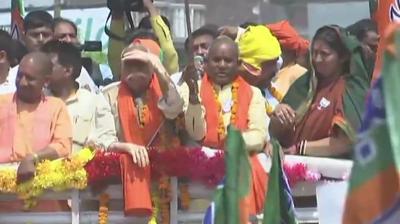
Smriti Irani files nomination from Amethi, after roadshow, Puja
Union Minister and BJP leader Smriti Irani on Thursday filed her nomination from Amethi parliamentary constituency. Earlier, Smriti Irani held a roadshow along with Chief Minister Yogi Adityanath. Earlier, Smriti performed 'Puja' along with her husband Zubin Irani....
read more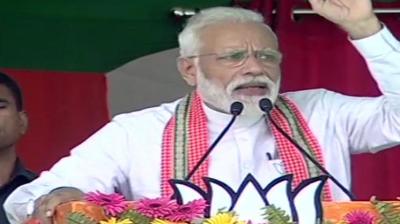
Mahamilavat gang scared I will shut their shops of corruption if back in power: Modi
Prime Minister Narendra Modi on Thursday launched a scathing attack on the Congress-led opposition, asserting that the "mahamilavati gang" is scared that if he comes to power again, their "shops" of corruption and dynasty politics will shut down. Addressing an...
read more
Laser pointed 7 times at Rahul’s head in Amethi: Congress writes to govt
The Congress has alleged a security breach of party president Rahul Gandhi during his visit to Amethi in Uttar Pradesh. The party referred to the day when Gandhi went to the constituency to file his nomination. According to Ministry of Home Affairs, they have not...
read more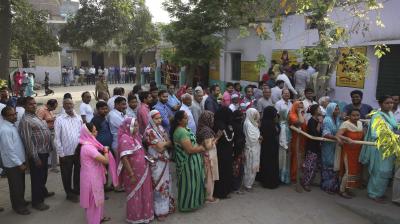
General Elections 2019, Phase 1: India decides for 91 LS seats, 4 states
India votes from today to elect the country’s 17th Lok Sabha, a process that will span seven phases till May 19. The verdict of the people is out on May 23. The second is on April 18, third on April 23 and fourth on April 29, fifth on May 6, sixth on May 12 and...
read more
Charlize Theron reveals she is ‘shockingly available’
Charlize Theron has revealed that she is "shockingly available" but the actor said she needs a man to "step up" and ask her out. The 43-year-old Oscar winner opened up about her love life in an interview with Entertainment Tonight while promoting her film "Long Shot"...
read more
Travelling to India awakened new understanding of myself: Will Smith
Hollywood star Will Smith says his trip to India awakened a new understanding of himself and the world around him. The actor, who visited Haridwar to shoot for his Facebook Watch show "Will Smith's Bucket List", took to Instagram Saturday to share the pictures of the...
read more
Ian McShane and David Harbour share great chemistry in ‘Hellboy’
Neil Marshall’s Hellboy is all set to open in theaters in a matter of weeks. In casting Hellboy’s adoptive father prickly Professor Trevor “Broom” Bruttenholm, the producers swung to acclaimed British actor Ian McShane who is best known for his Golden Globe -winning...
read more



